Apply for L1 Visa
The 8-Minute Rule for L1 Visa
Table of ContentsThe Basic Principles Of L1 Visa Some Known Details About L1 Visa Our L1 Visa StatementsGetting The L1 copyright WorkThe Single Strategy To Use For L1 VisaWhat Does L1 Visa Mean?
Available from ProQuest Dissertations & Theses Global; Social Scientific Research Costs Collection. (2074816399). (PDF). Congress. (PDF). DHS Workplace of the Examiner General. (PDF). (PDF). "Nonimmigrant Visa Statistics". Recovered 2023-03-26. Division of Homeland Protection Workplace of the Assessor General, "Testimonial of Vulnerabilities and Possible Misuses of the L-1 Visa Program," "A Mainframe-Size Visa Loophole".
U.S. Division of State. Obtained 22 August 2016. "Workers paid $1.21 an hour to mount Fremont technology firm's computers". The Mercury News. 2014-10-22. Gotten 2023-02-08. Costa, Daniel (November 11, 2014). "Little-known short-term visas for foreign technology workers depress salaries". Capital. Tamen, Joan Fleischer (August 10, 2013). "Visa Holders Replace Employees".
All About L1 Visa
In order to be eligible for the L-1 visa, the foreign firm abroad where the Recipient was utilized and the united state firm have to have a qualifying relationship at the time of the transfer. The different kinds of certifying connections are: 1. Parent-Subsidiary: The Parent suggests a company, firm, or various other lawful entity which has subsidiaries that it owns and regulates."Subsidiary" indicates a firm, company, or various other lawful entity of which a parent has, directly or indirectly, even more than 50% of the entity, OR owns less than 50% but has monitoring control of the entity.
Example 1: Company A is integrated in France and utilizes the Beneficiary. Business B is included in the U.S. and desires to request the Beneficiary. Business A possesses 100% of the shares of Firm B.Company A is the Parent and Business B is a subsidiary. For that reason there is a qualifying partnership in between the 2 firms and Firm B need to be able to sponsor the Beneficiary.
Instance 2: Business A is integrated in the U - L1 Visa.S. and wants to seek the Recipient. Firm B is integrated in Indonesia and employs the Recipient. Company A has 40% of Firm B. The remaining 60% is had and managed by Company C, which has no connection to Business A.Since Business A and B do not have a parent-subsidiary relationship, Company A can not sponsor the Recipient for L-1.
Firm An owns 40% of Company B. The remaining 60% is possessed by Firm C, which has L1 Visa law firm no connection to Business A. Nonetheless, Company A, by official agreement, controls and complete handles Business B.Since Company A possesses much less than 50% of Company B yet handles and regulates the business, there is a certifying parent-subsidiary connection and Firm A can fund the Beneficiary for L-1.
The Greatest Guide To L1 Visa
Firm B is included in the U.S.
An Unbiased View of L1 Visa

The L-1 visa is an employment-based visa category developed by Congress in 1970, enabling multinational business to transfer their managers, execs, or vital personnel to their U.S. operations. It is commonly described as the intracompany transferee visa. There are two major kinds of L-1 visas: L-1A and L-1B. These types appropriate for workers worked with in various placements within a business.

Additionally, the recipient must have worked in a supervisory, exec, or specialized worker position for one year within the 3 years preceding the L-1A application in the foreign firm. For new office applications, international employment must have been in a managerial or executive ability if the recipient is involving the United States to function as a supervisor or exec.
What Does L1 Visa Do?

If approved for a united state firm operational for more than one year, the first L-1B visa is for up to 3 years and can be prolonged for an extra 2 years (L1 Visa). On the other hand, if the U.S. company is newly established or has actually been operational for much less than one year, the initial L-1B visa is released for one year, with expansions available in two-year increments
The L-1 visa is an employment-based visa classification established by Congress in 1970, click here enabling multinational firms to transfer their supervisors, executives, or essential employees to their United state operations. It is frequently referred to as the intracompany transferee visa.
The 25-Second Trick For L1 Visa
In addition, the recipient needs to have operated in a supervisory, executive, or specialized worker position for one year within the 3 years preceding the L-1A application in the international business. For new workplace applications, foreign work has to have been in a supervisory or executive capability if the beneficiary is concerning the United States to function as a manager or exec.
for approximately 7 years to supervise the operations of the U.S. affiliate as an executive or manager. If issued for an U.S. business that has been operational for greater than one year, the L-1A visa is originally approved for as much as 3 years and can be prolonged in two-year increments.
If approved for a united state business operational for greater than one year, the initial L-1B visa is for as much as 3 years and can be extended for an additional 2 years. Conversely, if the U.S. company is newly established or has actually been operational for much less than one year, the preliminary L-1B visa is released for one year, with expansions available in two-year increments.